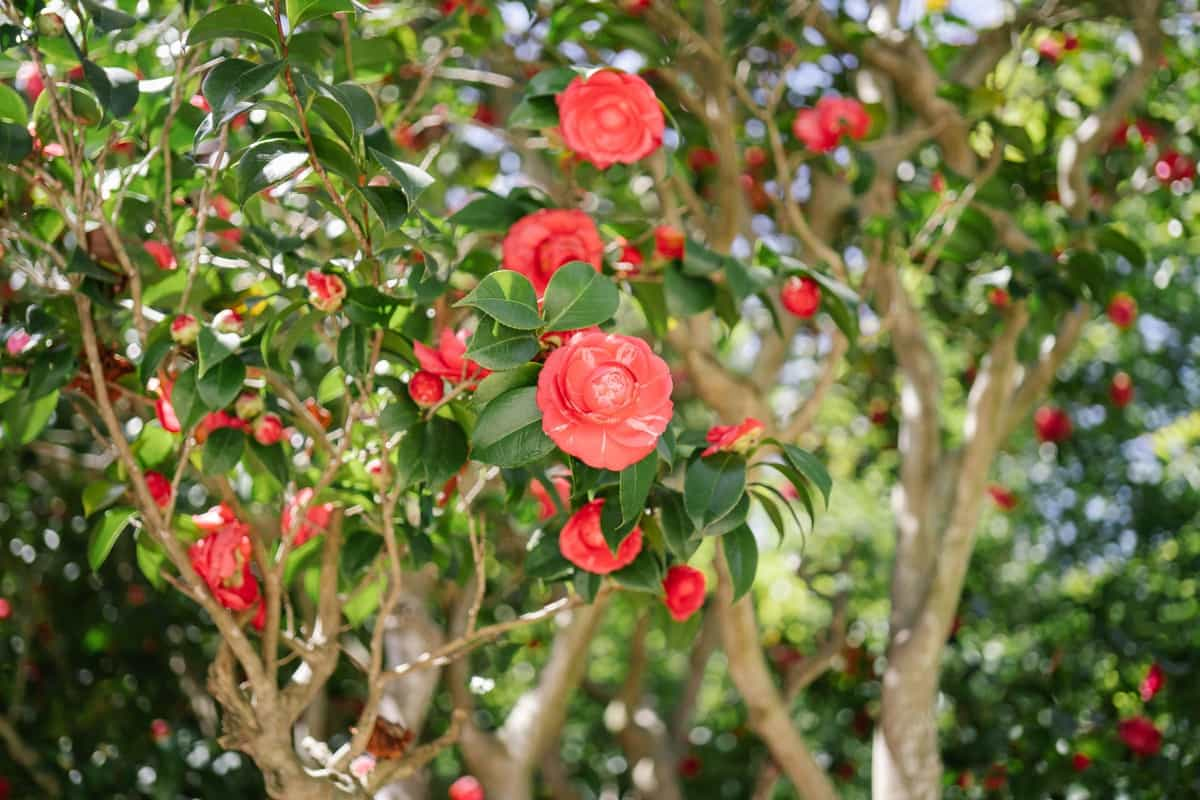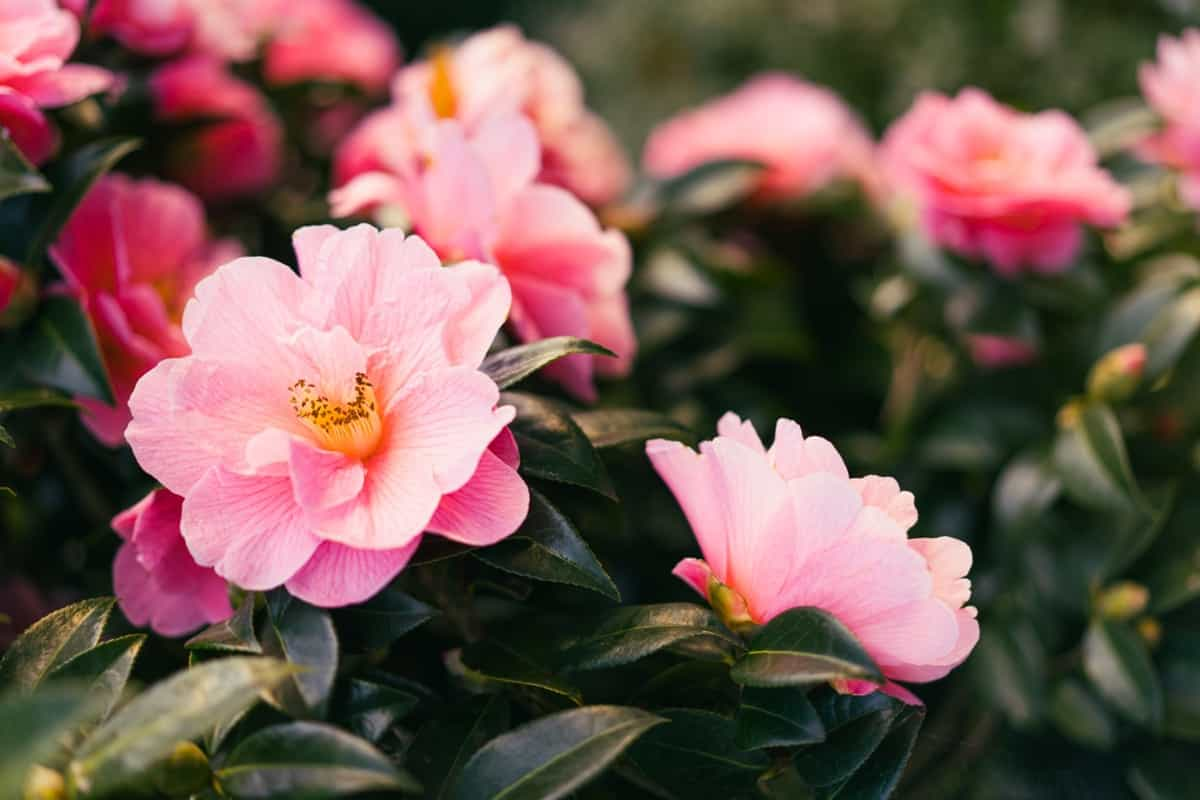Flowering camellia plants are known for their beautiful blooms and lush foliage. However, like other plants, they can encounter problems affecting their health and overall appearance. This document will explore common problems with flowering camellia plants and discuss potential solutions.

10 Common Problems With Flowering Camellia Plants
Yellowing Leaves on Flowering Camellia Plants
- When camellia plants have yellow leaves but no flowers, the most probable cause is a lack of nutrients. The treatment for these yellow leaves in camellia plants is, choose a fertilizer with a higher nitrogen content to stimulate foliage growth.
- Yellowing leaves with brown often indicate improper watering or inadequate drainage. Ensure the plants are not sitting in waterlogged soil, leading to root rot. Water the plants deeply but infrequently, allowing the soil to dry out slightly between waterings.
- If your camellia is turning yellow and falling off, it may be experiencing stress due to environmental factors. To fix the yellow leaves in camellia plants, ensure the plants receive adequate sunlight, as insufficient light can also cause yellowing and leaf falling off.
Bud Drop in Camellia Plants During Flowering
Camellias prefer cooler temperatures, but drastic temperature changes can lead to stressing your plant, resulting in bud drop during flowering in winter. Camelia has buds but no flowers; if the plant is not receiving enough light during the winter months, it may produce buds but fail to develop them into flowers.
Treating Bud Drop in Camellia Plants During Flowering
- Ensure that camellia plants receive consistent moisture, particularly during dry periods. However, avoid overwatering as it can lead to root rot.
- Protect camellias from extreme temperature fluctuations by providing adequate shelter and insulation during winter.
- To treat this bud drop, Apply a balanced supplement formulated for camellias to provide the necessary nutrients. Follow the dosage instructions for application rates and frequency.
Wilting or Drooping Camellia Flowers
Sunscald Treatment
- Provide shade for your camellia plants during the hottest part of the day, especially in summer.
- Reviving a camellia requires a combination of proper watering and addressing any underlying issues. Water the plants deeply and regularly, especially during dry periods.
- To prevent camellia flowers from wilting, ensure the soil is well-draining and organically rich. Regularly fertilize the plants with a balanced fertilizer specifically formulated for camellias to provide them with the necessary nutrients.
Pests Infesting Flowering Camellia Plants
One of the most common pests that affect camellia plants is aphids. To get rid of aphids on camellias, use a strong stream of water to wash off the aphids from the plant. Insecticidal soaps or horticultural oils can be used for the treatment of aphid infestations on camellia plants. Along with aphids, major pests like thrips, spider mites, and Camellia Scale also cause accountable damage to your Camellia plants. These pests feed on camellia flowers, causing discoloration, deformed petals, and reduced bloom quality. To control these pests,
| Pest | Control |
| Thrips | Insecticidal soap or neem oil, predatory mites |
| Spider mites | Horticultural oil or insecticidal soap, yellow sticky traps |
| Camellia Scale | Horticultural oil or insecticidal soap, a strong jet of water |
In case you missed it: 10 Common Problems With Lettuce: Treatment and Solutions

Fungal Diseases Affecting Camellia Flowers
- Camellia leaf blight is caused by the fungus Ciborinia camelliae. One of the best fungicides for leaf blight fungus treatment is chlorothalonil, which can be applied as a foliar spray according to the manufacturer’s instructions.
- Camellia flower blight, also known as petal blight, is caused by the fungus Ciborinia camelliae. The best fungicide for flower blight disease treatment is a product containing the active ingredient thiophanate-methyl for fungus treatment.
- Powdery mildew is another fungal disease commonly found on Camellia flowers. Treatment for this disease is fungicides containing active ingredients like sulfur, potassium bicarbonate, or myclobutanil can be applied.
Browning or Blemished Petals on Camellia Flowers
- Water your camellias deeply but infrequently, allowing the soil to dry out slightly between waterings. Avoid overhead watering, as this can contribute to fungal infections.
- Feed your camellias with a balanced fertilizer specifically formulated for acid-loving plants. Follow the dosage instructions for application rates and timing.
Camellia Plants Suffering From Nutrient Deficiencies
- Buds not opening: Insufficient nutrients can hinder the development and opening of camellia buds.
- Camellia plants turning brown: Camellia flowers can turn brown when the plants are deficient in essential nutrients. Brown spots or discoloration may appear on the petals, affecting the overall beauty of the blooms.
Treatment: Improve soil fertility and nutrient availability by incorporating organic matter, such as vermicompost or well-rotted animal manure. In severe nutrient deficiencies, foliar sprays can provide a quick nutrient boost.
Winter Damage on Flowering Camellia Plants
Camellias can suffer from freeze damage when exposed to extremely low temperatures. To prevent freeze damage, it is advisable to select camellia varieties more tolerant of cold temperatures, such as Camellia sasanqua.
Protecting Camellia Buds from Frost: Cover the plants with a breathable frost cloth or burlap. This protective layer will help retain heat and prevent frost from settling on the buds. It is crucial to secure the covering tightly to prevent it from blowing off during strong winds.
Camellia Care in Pots during Winter: Potted camellias should be placed in a sheltered location, such as a porch or garage, to protect them from extreme cold and wind. It is also important to monitor the moisture level of the soil.
Wrapping Camellias for Winter: Start by loosely tying the branches together with twine to prevent them from snapping under the weight of snow or ice. Next, wrap the entire plant with a burlap layer, ensuring it is secured tightly. This will act as a shield against freezing temperatures and wind.
Improper Pruning Causing Problems for Camellia Flowers
Improper pruning leads to buds not opening since camellias are sensitive to heavy pruning. Excessive removal of branches can stress the plant and hinder its ability to produce flowers. Be selective and cautious when pruning camellias, focusing on removing dead, damaged, or diseased branches while preserving the plant’s overall structure. To revive camellias that have been affected by improper pruning, a few steps can be taken. First, assess the damage and remove any dead or diseased branches, making clean cuts just above a leaf node or bud.
Flowering Camellia Plants Not Producing Blooms
Most camellias flower at an early age, but some will not flower until they are five or older. Adverse conditions, particularly dry soil, occurring in late summer or early spring can cause the buds to abort. Ensure that your plant has an adequate water supply during this critical time. Excessive or late feeding can also lead to bud drop. To encourage your abundant flowering in camellia plants,
- Proper pruning helps maintain the plant’s shape, removes dead wood, and stimulates new growth, resulting in more flowers.
- Regularly feed camellias with a balanced fertilizer to ensure they receive essential nutrients for optimal flower production.
In case you missed it: Top 8 Organic Solutions for Onion Pests and Diseases

Conclusion
By addressing common problems with camellia flowering plants and following the appropriate treatment and solutions, you can ensure the health as well as vigor of your flowering camellia plants. Regular observation, proper care, and timely intervention will help you maintain beautiful and thriving camellia plants in your garden.
- Feed Your Flock for Less: Top 10 Tips to Save on Chicken Feed
- Ultimate Guide to Ossabaw Island Hog: Breeding, Raising, Diet, and Care
- Hatching Answers: The Top 10 Reasons Your Chickens Aren’t Laying Eggs
- Eggs and Economics: Breaking Down the Cost of Raising Backyard Chickens
- Defend Your Greens: Proven Methods to Keep Iguanas Out of Your Garden
- Ultimate Guide to Cinnamon Queen Chicken: A Comprehensive Guide for Beginners
- Ultimate Guide to California Tan Chicken: Breeding, Raising, Diet, Egg-Production and Care
- Ultimate Guide to Marsh Daisy Chicken: Breeding, Raising, Diet, and Care
- 10 Types of Chicken Farming Businesses You Can Start for Profits